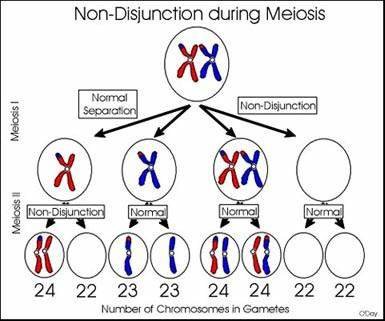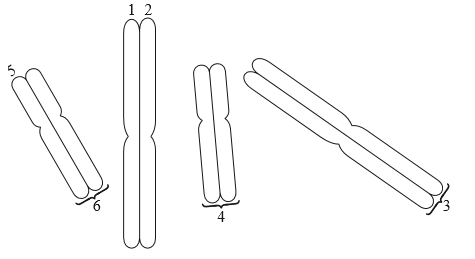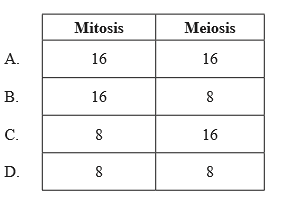IB Biology SL (Standard level)- 2024 – Practice Questions- All Topics
Topic 3.3
Topic 3 Weightage : 23%
All Questions for Topic 3.3 – Meiotic Division, Sister Chromatids, Stages of Meiosis, Crossing Over, Random Assortment, Sexual Life Cycle, Genetic Variation, Non-Disjunction, Karyotyping, Drawing Meiosis, Mitosis versus Meiosis, Somatic vs Germline Mutations, Polyploidy
Question
Which statement applies to meiosis and mitosis?
Meiosis occurs in a greater number of locations in the body compared to mitosis.
Separation of chromatids occurs in both meiosis and mitosis.
Recombination occurs in both meiosis and mitosis.
Reduction in chromosome number occurs in both meiosis and mitosis.
▶️Answer/Explanation
Ans: B
Separation of chromatids occurs in both meiosis and mitosis because it is a way of dividing the replicated DNA copies into two nuclei. However, the separation happens at different stages of the cell division process. In mitosis, chromatids separate in anaphase, which is the third stage of mitosis. In meiosis, chromatids separate in anaphase II, which is the third stage of the second round of meiosis. In anaphase II, the sister chromatids are pulled apart by spindle fibers and move to opposite poles of the cell. This happens after the homologous chromosomes have separated in anaphase I, which is the first round of meiosis. The separation of chromatids ensures that each daughter cell gets a complete set of chromosomes.
What is the chromosome number in a human gamete with non-disjunction?
A. 46
B. 45
C. 24
D. 23
▶️Answer/Explanation
Markscheme
Ans:C

The haploid number for humans is 23, so normally a human gamete would have 23 chromosomes. However, sometimes there is a failure of chromosomes or chromatids to separate properly during cell division, which is called nondisjunction. This can result in gametes with an abnormal number of chromosomes, which is known as aneuploidy. For example, if nondisjunction occurs during meiosis I or meiosis II, a human gamete could end up with 24 or 22 chromosomes instead of 23. This can cause genetic disorders such as Down syndrome (trisomy 21) or Turner syndrome (monosomy X). Therefore, the chromosome number 24 in human gamete is with nondisjunction.
A body cell of a goat has 60 chromosomes. What would be produced following meiosis in the testis of a male goat?
A. 2 cells each with 60 chromosomes
B. 4 cells each with 60 chromosomes
C. 2 cells each with 30 chromosomes
D. 4 cells each with 30 chromosomes
▶️Answer/Explanation
Markscheme
Ans:D
The female goat also has 30 pairs of chromosomes. 30 chromosomes come from her sire and 30 come from her dam. The female goat has two X chromosomes. The autosomes are similar to the autosomes of the male goat1.
However, during meiosis, a cell divides into four cells, each with half the number of chromosomes as the original cell.
In the following diagram, which pair represents homologous chromosomes?

A. 1 and 2
B. 3 and 4
C. 2 and 5
D. 4 and 6
▶️Answer/Explanation
Markscheme
Ans:D
Homologous chromosomes are pairs of chromosomes that have the same length, centromere position, and gene loci. They are inherited from the mother and father of an organism. A karyogram is a picture of the chromosomes of an organism arranged in homologous pairs of decreasing length. Therefore, homologous 4&6 chromosome pairs are of same length in digram because they have the same structure and genes.
If there are 16 chromosomes in a cell that is about to divide, what will be the number of chromosomes in a daughter cell after division by mitosis or meiosis?

▶️Answer/Explanation
Markscheme
Ans:B
The number of chromosomes in the daughter cells after mitosis will be the same as the parent cell. So if there are 16 chromosomes in the parent cell, there will be 16 chromosomes in each of the daughter cells after mitosis.
In contrast, meiosis gives rise to four unique daughter cells, each of which has half the number of chromosomes as the parent cell and became 8.
Question
Which event occurs in the first division of meiosis?
A. Synthesis of DNA
B. Pulling apart of sister chromatids
C. Halving of the chromosome number
D. Division of centromeres
Answer/Explanation
▶️Ans:C
The number of chromosomes is halved in meiosis. This makes diploidy possible because the gametes that are produced with half the chromosome number of their parent cells can then fuse to form a diploid zygote. Essentially, the chromosome number of the cell is halved once meiosis I is completed. For this reason, the process is a reduction-division.
IBDP Online Test Series By iitianacademy
Comprehensive Test Preparatory package targeted towards IBDP